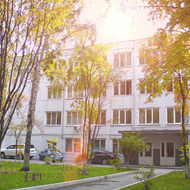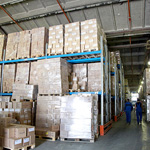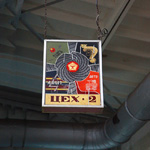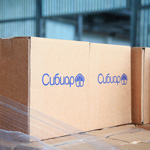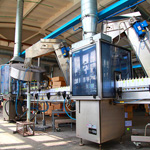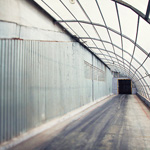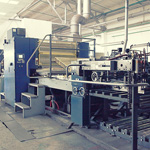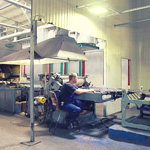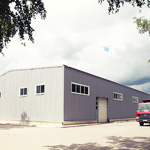Company History
45 years
of experience translate to prosperity, maturity and well-informed decisions. We have worked hard to gain this experience and are determined to continue our history in the right way.
Over this period we have acquired not only many years of experience and a good position in our market segment, but also business partnerships. After all, honesty, professionalism and respect for your commitments are crucial elements of successful, fruitful and beneficial cooperation.
The value of reviews from our customers and partners cannot be measured in money and material things. We prize recognition of our achievements and the results of cooperation.
31 December 1974
The Story Begins
The birth of Sibiar (formerly Novosibirsk Household Chemical Factory) can be called a true New Year's miracle. After all, the State Commission signed the act to put the factory complex into operation on 31 December 1974.
Colour Printing
on Tin Cans
During the first five years, the plant mastered production of soldered cans with colourful lithographs on the sheet metal casing.
We were the first in the Soviet Union who were able to do that. At the same time, we did not rest on our laurels and continued our development.
On-site
Infrastructure
Our production gradually gained momentum until 1998, as we widened our product range and created our own facilities with the necessary machinery and equipment.
Western Partners
We implemented new technologies, switched to modern European standard quality raw materials and established working relationships with Western partners. We still work with some of them today.
Ozone-safe Propellants
Eco-friendly Technology
2000
Thanks to the installation of a Swiss automatic welding machine, we were able to launch production of welded containers, whose appearance is in no way inferior to the best foreign counterparts.
2001
In 2001, all our production was moved onto ozone-friendly propellant. Environmentally friendly production is one of the
company's priorities.
High Quality Output
We dedicated the next ten years to completely reorganising the manufacturing process and continuously raising the quality requirements for our products.
Contract Manufacturing
2002
We brought a new automated high-speed production line into service. The latest Swiss and German equipment can produce cylinders of various heights in two standard sizes and carry out additional quality control.
2003
In 2003, we began production on a contract basis in order to manufacture products under clients' private brands.
2004
Perfumes and Cosmetics
In 2004, we opened separate manufacturing facilities for perfume and cosmetic products that meet new stringent
sanitary requirements.
Quality Systems Certificate
In the same year, we received the ISO 9001 Quality Systems Certificate. A significant event that once again underlines our commitment to quality production.
Expansion of Operations
Gas for Hand-held Devices
In 2009, we became the first company in Russia to launch canisters of propane-butane gas for portable devices.
Sibiar gave all its customers a present to celebrate its 35th anniversary by releasing a 1000cm3 spray can.
Long-term Cooperation
We continued to forge strong and lasting relationships with clients. In 2010, a contract was signed with hypermarket chain Lenta regarding preproduction and manufacturing of air fresheners and haircare products. The private brand 365 Days is the best proof of our successful partnership.
Dependable Partnerships
People are the most important thing in any line of business, along with trust on the part of employees, business partners and customers.
We could not have enjoyed success without them. That is why our mission statement is as follows: Commercial considerations and personal gain will never make us betray our principles of reliability and quality.
Warehouse Management
In 2011-2012 we started to reorganise storage facilities for raw materials
and finished products.
Manufacturing
We make hair styling products, deodorants, antistatic agents, air fresheners, household polishes, cleaning products for various surfaces, insecticides, insect repellents, car care products, and refills for gas lighters and other portable gas appliances.
The result of the company's intelligent and structured approach to achieving high performance on the factory floor.
aerosol units per year
— Sibiar's operational capacity
— members of staff
Our highly professional and responsible personnel ensure fulfilment of the whole production process from design to manufacturing.
— Our product range
record in aerosol production.
Information about Aerosols
An aerosol can is used to spray liquids, obtain foam from liquid materials and squeeze out various paste-like mixtures. Aerosol units are most commonly utilised to spray liquid substances in the home, agriculture sector, healthcare, industry etcetera.
Stain removers, cleaning products, polishes, substances used to control insects, odour removal tools, various disinfectants and many more are examples of household aerosols.
The Origins
of the Spray Can
Rotheim's canister is the ancestor of all modern aerosols. In 1926, Eric Rotheim was the first person to apply for a patent on an aerosol container. As the story goes, the invention owes its further development, improvement, and, most importantly, mass popularity to Lyle Goodhue and William Sullivan, office workers at the U.S. Department of Agriculture. But the main "culprits" in the device's rise were World War II and...mosquitoes!
This case can be regarded as another example of one of the major conditions for an invention's successful implementation: there has to be a need for it. This need appeared at the U.S. Department of Defense during combat operations in tropical areas, where various blood-sucking insects were the biggest problem for the military. Lyle Goodhue and William Sullivan were set the challenge of fighting the insects, or rather searching for the most effective ways to do this in tropical combat conditions. It should be said that all the spray cans mentioned above were reusable.
The disposable design was created by Robert Abplanalp. He invented a new valve that remains virtually unchanged to this day. This was just part of the complex project that resulted in the emergence of the disposable spray can.
Soldiers just had to spray insecticide from the small portable cans in their tents to protect themselves against malarial mosquitoes. The innovation was so effective that it was nicknamed the “bug bomb”. Besides finding optimal shapes and designs for conventional cylinders with traditional contents, a lot of work was done to adapt them for different materials and other areas of application, as a result of which the product mix of aerosols increased steadily.
The disposable spray can is in great demand in today's world as a means of packaging, distributing and using various materials.
Usage instructions are indicated
on the label of the spray can
Before use, carefully read the usage instructions of the product that you have purchased.
Observe safety precautions when using spray cans
Aerosols are Safe
for the Environment
There is a widespread belief that all domestic aerosol products are harmful to the environment and the ozone layer of our planet. We would like to dispel this myth!
Indeed, the gas freon was formerly used as a propellant in aerosol cans. The gas is one of the chlorofluorocarbons (CFCs) and really does destroy the ozone layer. For half a century CFCs, first obtained in 1928, were wrongly considered miracle substances because they are non-toxic, not flammable, do not dissolve in water, and are easy to manufacture and store.
Damage to the ozone layer is one of the factors that causes global climate change on our planet. The first report about the ozone-deficient zone above the Antarctic was published in 1985. The term “hole in the ozone layer” emerged in the media. It is, of course, not quite correct, as it is impossible for one region on Earth to be left without any ozone protection at all. The "ozone hole" just means that the annual spring decrease in ozone over Antarctica exceeded the norm.
Strong measures were taken to restore the ozone layer immediately after discovery of the "ozone hole". In September 1987, 23 countries signed the Montreal Protocol on Substances that Deplete the Ozone Layer to phase out and eventually eliminate the use of substances that are harmful to the Earth's ozone layer. Since then, other countries have joined the convention and it has been ratified by close to 200 states. As you can see, the use of CFCs in aerosol products is now banned worldwide! Chemists are actively seeking substitutes for CFCs. Today, many countries, including Russia, use hydrocarbon propellants instead of CFCs.
A hydrocarbon propellant is a highly purified propane-butane mix used as a gas propellant for aerosol dispensers. It has zero ozone depletion potential (ODP). Hydrocarbon gases were formally approved by the United Nations Environment Programme (UNEP) in 1993.
At present, this propane-butane mix is the only propellant used in Sibiar's production. It is harmless to the ozone layer and the environment. When you use Sibiar sprays, you can be sure that these products are made according to the latest safety requirements!





